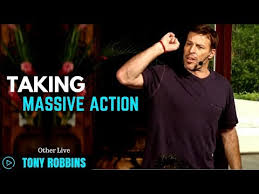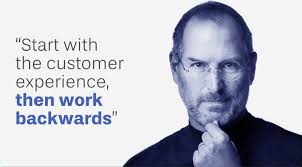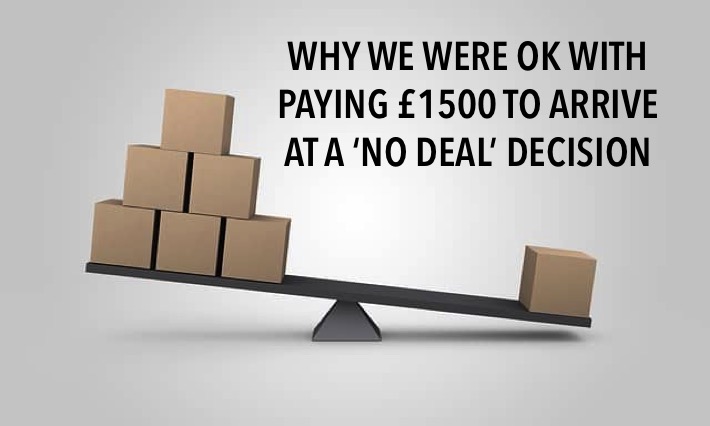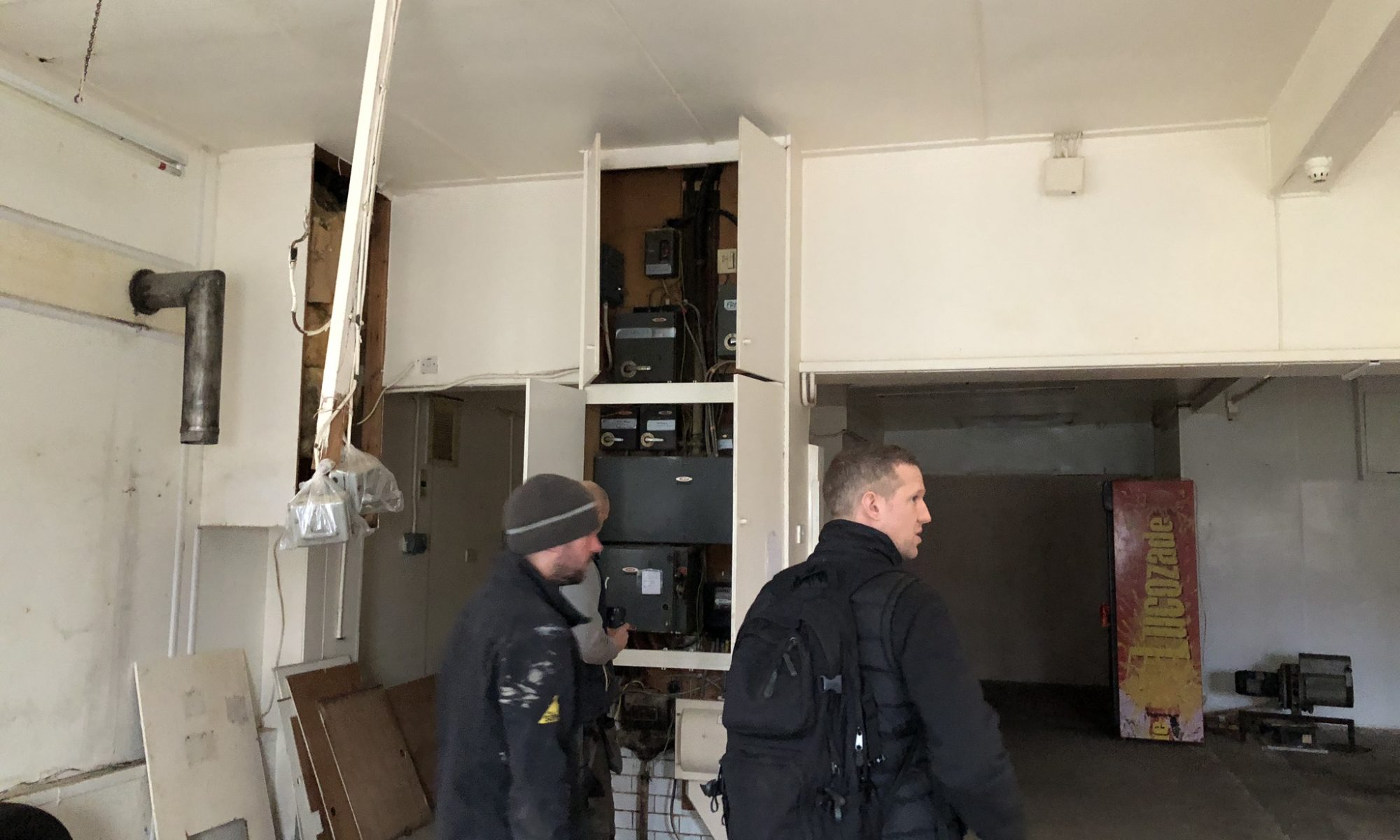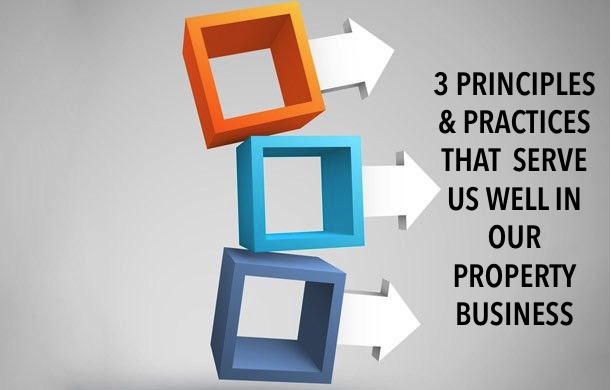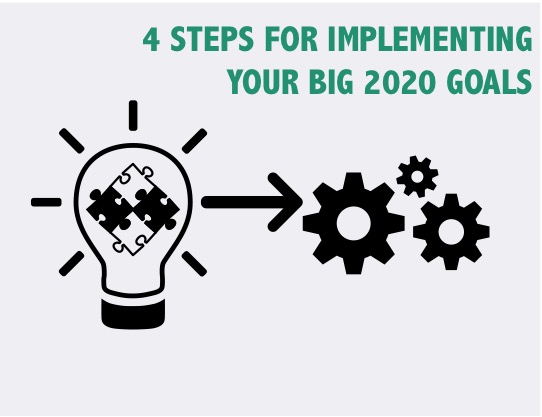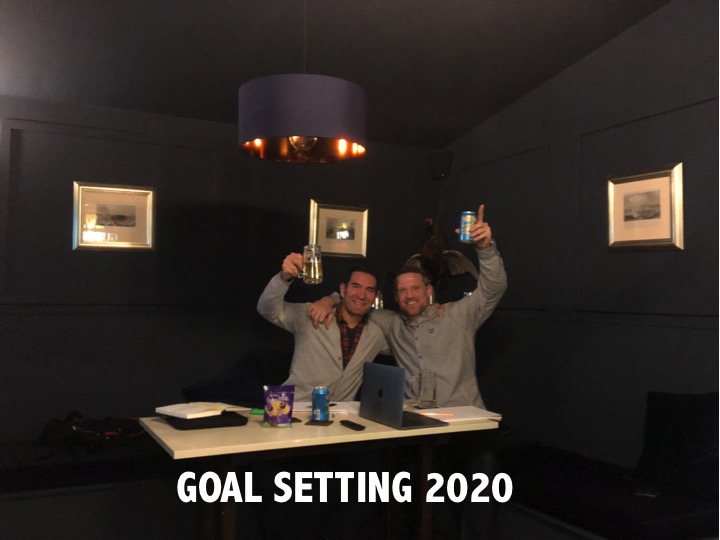HOW TO TAKE MASSIVE ACTION – AN INSIGHT FROM TONY ROBBINS
TRAINING YOUR PROPERTY ENTREPRENEUR BRAIN
WHY WE WERE OK WITH PAYING £1500 TO ARRIVE AT A ‘NO DEAL’ DECISION
During this last week of mastermind sessions I was hosting, the topic of decision making came up as a frequent theme – decision making in relation to which property strategy, which deal, what to focus on and similar such decisions.
All of those conversations reminded me of the various deals that Chris and I have analysed and made decisions on whether to proceed or not. One such deal and decision I thought worth sharing was an expensive one to arrive at – it cost us £1500 to arrive at a ‘no deal’ decision, but you know what, we were totally OK about it.
I’ve recorded an overview video to provide some context and rationale to the decision making since Chris and I learned a lot from the exercise and thought others may learn from a quick peek behind the scenes too.
What this video covers:
-quick bit of context to a mixed use development of 27 flats and over 400SQM of retail space
-our estimated figures vs the cost plan figures from a Quantity Surveyor
-a quick look at what’s inside a paid for preliminary cost plan
-why were totally OK with spending £1500 to arrive at the decision to walk away
I’ve mentioned on several occasions that I’m a firm believer of the maxim that your success is 80% mindset and only 20% mechanics. There will be many occasions where missing out on a potential deal to a higher bidder, or having to walk away after weeks of analysis will leave you feeling downhearted. The antidote to that however is being clear on your deal criteria, and of course more deals in the pipeline to look at.
Here’s a link to my previous post on the importance of deal flow if you missed it
What tough property decisions are see-sawing in your head at the moment?
THE BENEFITS OF ‘BOARD’ MEETINGS IN THE MOUNTAINS
Over the past week I’ve had the opportunity to experience the amazing mountains of St Anton and create rich memories with my best and oldest buddies.
This week long trip has only possible thanks to a handful of key things:
⁃ My loving and supportive wife looking after our 3 wonderful boys
⁃ Our brilliant team in the form of business partner Chris and Ops Manager Louise running the show at home
⁃ The property assets we have and a property trading business (in SA), all of which generates a healthy slice of financial and time freedom.
Week’s like this, out of your business, are not only special, fun and sacred, but subconsciously they are incredibly beneficial to your productivity. If that sounds counterintuitive, please bear with me because it’s an important concept for everyone to take on in their own context.
I’ve previously written about the 4 pillars of productivity ie the 4 key ingredients behind taking action and completing projects- those 4 keys are:
#1 – SPECIFICITY
#2 – MEASUREMENT
#3 – DEADLINES
#4 – ACCOUNTABILITY
If you haven’t seen that post and would like to read up on it, here’s a link:
http://adaeroproperty.com/week-49-the-four-pillars-of-productivity/
SO WHY IS HAVING A FUN PACKED WEEK OUT OF THE BUSINESS GOOD FOR PRODUCTIVITY?
The aptly termed ‘Board’ meeting in the mountains with important people in my life brings with it so many great benefits, even beyond the fun experiences on the snow, laughs and memories made. Here’s what I mean:
* Disconnected time away from the business actually makes you hungry to get back into producing mode and working at being the highest leverage version of yourself in moving your business forward. I can honestly say I’m hungry to get back to business this week, and hopefully progress some exciting opportunities – a) with a commercial property and b) with some prospect contractor SA bookings.
*Having let the proverbial ‘inner child’ out to play I can happily put the head down and focus on the hard work for another period of time without feeling frustrated or exposing myself to higher risk of procrastination had I not taken any time out.
*Changing up my environment and routine for a week has removed me from the day to day blinkers and made way for some creative thinking thanks to inspiring sights, new conversations, ideas and perspectives- for example it reconnects me to a big goal Chris and I have to build a spectacular ski chalet where we can host mastermind retreats and gift holidays to causes that are close to our hearts – eg a place where families dealing with cancer can come away to create wonderful memories.
*I’ve continued to feed the virtuous cycle – ie when we spend money on experiences with close friends/family it not only creates wonderful memories but it inspires us at a different level to continue to produce results and create a life we are proud of.
*Absence makes the heart grow fonder – with a bit of time away from my beautiful wife and kids I miss them more as each day passes but that only serves to appreciate them even more, and I return home more loving and patient.
So, whilst it’s not a definitive list, there’s 5 major benefits I wanted to share from having ‘board’ meetings in the mountains.
I know the mountains will not be for everyone, but replace that with whatever lights you up. In striving to start and grow our property businesses we can at times be our own worst enemies, pushing so hard, thinking we have to optimise every waking hour, but over time that’s not actually serving us.
So, in conclusion, I’d encourage you all to be intentional about scheduling time for PLAY, even better, share here what fun you have planned for the months ahead.
LIVE COMMERCIAL PROPERTY DUE DILIGENCE
This week Chris and I wanted to bring to life some of the due diligence and analysis process that forms part of our approach to commercial property investing.
This opportunity we have captured has come about because we stuck to those principles I shared in last week’s post. If you missed it you can catch up by clicking here
With that said, this video provides a nice follow up to last weeks post and helps bring to life some of things I referenced, for those interested. I outlined in that post the approach we are taking to our commercial property investing ie following our D.I.C.E model that I’ve written about in my book.
Whilst there are plenty of vacant commercial properties for sale that we could go and view and try to figure out what to do with, we have instead chosen to invest our energies in first finding the end customer, and then go out to help create a solution for them. Yes it takes a good deal of leg work to originate an opportunity and then to try and line everything up, but the end result we are striving for creates a much sweeter investment.
Here we are following a walk round with our trusty plumber and electrician who were helping us gauge how easy/hard it would be to split and upgrade the services. [If this is of interest then worth also looking out for the videos and photos Chris will be sharing as he’ll give you an insight to what his expert builder’s eye picks up].
Certainly feeling excited about this one but a lot of leg work still to do.
3 PRINCIPLES AND PRACTICES THAT SERVE US WELL IN OUR PROPERTY BUSINESS
This week’s activity has validated certain principles and practices that Chris and I have set and work to in our property property business. These are kind of unwritten rules that we have but have never formally articulated or shared until now. This is by no way an exhaustive list of how we operate but they are 3 principles/practices that we stick to, and because of that they have served us well in the last week.
Here are those 3 simple principles
- Keeping in touch with commercial surveyors
- The Importance of keeping records and notes on deal analysis
- Sticking to your investment principles
Hopefully principles like these will validate what you are already doing or help those still formulating their own. I’ll briefly unpack and explain each of these and why it has helped us this week.
SIMPLE PRINCIPLE #1: KEEPING IN TOUCH WITH SURVEYORS
Our January check ins with the surveyors we had developed relationships with last year led to us being notified about two properties we were interested in last year that are now back on the market. These were potential deals involving commercial property that we put a significant amount of due diligence into but neither came to fruition due 1) the vendors going cold 2) our offer on one property wasn’t accepted.
A phone call last week and a follow up coffee meeting this week with our friendly surveyor resulted in the news that both of these potential deals are now live again for us to have a second crack at the whip.
LESSON – keep in regular contact with the surveyor contacts you make and diarise check in calls/emails for time intervals that suit you. Build a relationship with these professionals and take them for coffees.
SIMPLE PRINCIPLE #2: KEEPING NOTES AND RECORDS ON DEAL ANALYSIS
Our ability to re-familiarise ourselves with these two property opportunities was pretty quick because we keep all of our deal analysis and associated notes in excel sheets in our shared google drive.
Whilst it is not a sophisticated CRM, we have all of our calculations, area comparables and summary notes from conversations with surveyors, agents etc all captured in those excel sheets filed in the google drive under the appropriate label so we can easily find it. This has meant getting our heads back into past due diligence has been swift and as it was 6-10 months ago we can now build on our area diligence easily and add a few lines for more recent comparables etc.
LESSON- whether you capture your deal analysis in paper form or in a google drive like us, the key is to file and keep it as you never know when it might need to be revisited. We see it as adding to the library of your intellectual property. Over time you will build up local market intelligence based on the analysis you do, comparables you find and the conversations you have. It will mean you are not starting again from scratch every time you go to analyse a deal of the same type or in the same area.
SIMPLE PRINCIPLE #3: STICKING TO YOUR INVESTMENT PRINCIPLES
Mistakes and successes over time in the property game has led us to evolve and create an approach to investing that we now apply across every property consideration. The investment philosophy we live by is our D.I.C.E model which I explain in detail in my book Predictable Property Profits.
One of the strategies that Chris and I have been building the foundations on around this D.I.C.E model is the very attractive targeted commercial investment. In simple terms that would look something like this – Find a commercial tenant with a need to expand into a new location and ascertain their property requirements; go hunting for a vacant property that will provide the end result that the tenant wants; gain some commitment from them ie an agreement to lease; acquire the vacant building, do the required refurb works, get the tenant in place, refinance at the higher commercial valuation; move onto the next deal.
We love this approach in the commercial space because it ticks all of our boxes. In particular it removes a lot of the guesswork and bakes a high degree of certainty into the deal, something that is paramount to us, especially when working with JV investors.
Circling back why this principle served us this week – there was a detached shop with uppers building for sale that was brought to our attention last Spring. The attractive thing about this was that even though geographically far from us, there was interest from a major charity to let it. We chipped away at this for several weeks to try and line up a mutually beneficial deal for all parties but in the end weren’t able to bring it to a conclusion.
In our catch up with our surveyor this week, we were informed that the building was back up for sale, but now going to auction with a pretty low guide price. Naturally Chris and I were pleasantly surprised and picked up our diligence where we left off to try and structure the deal. First port of call was the commercial agent representing the charity, and whilst that very helpful call provided an answer it wasn’t necessarily the answer we wanted to hear – the premises was no longer on the radar and there certainly wouldn’t be a conversation about an agreement for lease in the near future.
LESSON- Even though this property could be picked up cheap [potentially around £50K for over 3000 SQFT of high St property] without the certainty of end user it no longer qualified to fit our model. We were not about to speculatively have a gamble with a property far from our home area just because it was cheap.
In a previous stage of our property journey that decision to move on would have been way more difficult, but now with a clear set of guiding principles on how we invest, it made the decision clear, logical and swift.
In the week ahead we are focusing on bottoming out the other opportunity that is live again.
What are some of your guiding principles and practices that continue to serve you in your property business?
HOW TO CHECK IF YOU ARE DOING WHAT YOU KNOW [AND PROMISED YOURSELF]
So here we are 3 weeks in and 2020 is well underway. Chris and I had some great meetings and calls this week with various people who currently are, or will soon be, key figures in our extended power team. In those conversations I think we all felt this was about the last week we can get away with saying ‘Happy New Year” :). A couple of those calls/meetings involved commercial surveyors/agents – in picking up with them again after the holidays we are now excited to be revisiting a couple of potential deals that went cold last year but where the timing could be right now, in addition to some potential new avenues to explore in regards creating commercial deals that fit our DICE model.
Anyway, back to the message in this week’s post – by now everyone has some goals set and possibly some new habits being introduced. Just like we know that gyms are packed in the first few weeks of Jan, we also know the intended good practices at the gym and at work can slip away by February. Well if you’re interested in making sure your good intentions for your property business don’t dissipate, here are 12 questions to check in on yourself. I learned these from Darren Hardy early last year and having noted them in my journal I’m going through them now for my own benefit. I hope you can benefit from asking these of yourself also.
12 QUESTIONS TO CHECK IF YOU ARE DOING WHAT YOU KNOW YOU SHOULD TO GROW YOUR PROPERTY BUSINESS
[the short sentences in the parentheses highlight the harsh truths that may be going on inside your head, hopefully not however 🙂 ]
#1: Do I have a weekly calendar with slots booked for my most valuable priorities, before each new day starts? [so I can create rather than react]
#2: Do I allow too many interruptions during the day from friends, family, customers, prospects, team members to interrupt my flow and deep concentration work? [because it’s a welcome relief from the hard work of creating and finishing something]
#3: Do I talk a lot, extending conversations into longer chit chats when unnecessary? [because it’s seemingly justifiable to delay the hard work of creating]
#4: Do I multi-task? [even though I know it reduces my intellectual ability and causes me stress and anxiety]
#5: Do I love the adrenalin buzz of being overly busy? [in order to feel a sense of importance and self esteem even though it’s at the demise of my actual productivity]
#6: Is living in chaos and constant motion more comfortable to me than stilling my mind and single tasking? [because I might fear to be alone with my own thoughts]
#7: Do I find it really difficult to say no? [because I am too needy for approval and lack the self confidence to stick to my own priorities]
#8: Do I often find myself in a crunch to finish projects because I’m in over my head? [because I allow myself to be everyone else’s whipping boy/girl and don’t protect my own priorities]
#9: Do I spend hours needlessly on social media? [to escape and distract me from what’s most important]
#10: Do I waste time doing repetitious, non-vital and inessential tasks? [because I haven’t put systems in place to automate or eliminate]
#11: Do I maintain control of nearly everything because I believe no one else can do it as well? [which makes me an egotistical and delusional narcissist]
#12: Do I believe I can’t afford to hire someone to help me? [because I don’t actually value my time, my family and my health appropriately]
If you’ve read this far, you might like me have thought woah- those questions can be quite harsh and cutting. They are, but answering them for ourselves can only help by shining a light on what we need to keep us progressing in an optimal fashion. For me personally, I’ve noted some actions needed under questions under 4, 7 and 10.
Have these questions shone a light on something helpful for you?
4 STEPS FOR IMPLEMENTING YOUR BIG 2020 GOALS
Last week’s post on ecological goal setting seemed pretty well received, so thanks for the kind comments and engagement. The natural next step is to follow up that deep thinking around setting the right kind of goals for YOU, with an implementation plan. That’s what I’m going to outline here.
In the last post I wrote about how to set psychologically optimised goals that are congruent ie your conscious and unconscious mind are aligned in relation to the goals you set. Getting this right at the beginning is essential!
In the goal setting process it’s easy to get excited in the now by writing down a big goal but the science of achievement requires us to connect the dots between a Big Hairy Audacious Goal (BHAG) and what exactly we need to be working on quarter to quarter, month on month and how we’re using our time each day.
The big rationale behind artful implementation is to take the time to do strategic planning now so that at no time during the quarter are you at the desk on a Monday morning wondering what to do to get started (or at least it will be significantly minimised).
An implementation plan prevents that brain fog, but sadly investing the time to create such a plan is the most common part of goal setting that people skip. But not YOU, and not this year! It’s often looked at as too much like hard work- and you know what, it is hard mental work! Most good things do require some uphill struggle, but it’s also where we can get most clarity. I heard a brilliant quote a while back from one of the greats that ties into this point, it goes;
“People have uphill hopes, but downhill habits”
– John C Maxwell
In other words, we all want the things that require ‘uphill’ efforts, but are we willing to put in the work that builds the ‘uphill habits’ that will get us there?
You need to take your big 2020 goals and translate them into a project plan. This part of the process is uncomfortable, which is why people skip it but having a well thought through plan will keep you aligned, in the zone and knowing what you have to do next. BHAGs don’t manifest on their own, it takes real intentional work to dream them up, plan the road map, and then of course execute on that plan.
Here’s a quick summary of the process for artful goal implementation that I’ve been taught and continue to use each year. (Chris and I do invest multiple hours in goal planning in the opening weeks of Jan)
IT’S TIME TO BUILD THE FOUNDATION OF YOUR YEAR!
STEP #1: List your key projects
Taking everything into account, list 5-20 projects that would have an immediate impact on your business. With this list you are thinking up all the growth driving activities that move you closer to achieving the BHAG (ie various strategies and tactics you want to try that would/could result in a net positive to the business).
STEP #2: Now eliminate all but 3, and ask yourself:
– are you able to complete each one in a 12 week period?
– can you complete these with your current resources ie time, people, money?
– prioritise those projects that can feasibly meet the above
STEP #3: BUILD THE OUTLINE PLAN
Now for each project, build the outline for your implementation plan by completing a handful of answers to these 4 foundational productivity questions:
For project 1
#1 What specifically needs to happen…to get started? To continue? To finish?
#2 How can you measure progress? (ie no. of viewings/offers per week. Booking revenue, occupancy by month..) When answering these questions think about what can be ritualised/repeated by you and/or your team. Think about the input activity required to achieve the desired property outcome.
#3 What deadlines need to happen within 12 weeks? Think it through and allocate deadlines you can put into your diary. These will serve as milestones and checkpoints towards your completion point and get your mind clear on hitting them by certain dates.
#4 How can you stack multiple layers of accountability onto this project. In other words, who all can you inform, involve, make a pledge to etc that will help you follow through on your promise. Think mentors, family, advisors, peers).
Do the same for Projects 2 and 3. It’s a good idea to have no more than 3 projects in a quarter, and if one is particularly all consuming then stick with just that one project for the entire 90 days.
STEP #4: 12 WEEK PROJECT PLAN
The final stage to this is creating your 12 week project plan where you literally create a grid with 84 days and then populate it with dates, specifics and deadlines (as per your answers to the Q’s above) to work to each day and week. Schedule this stuff in using the mechanisms that work for you, phone, outlook calendar, a wall chart or whatever. Allocate sufficient time and protect it in your diary.
And there you have it. With clarity on what your goals are and your planning complete, now its all about taking action consistently each week.
I’d love to know if you complete this exercise, let me know if you do and you will massively increase the likelihood of following through.
Go for it!
HIGHLIGHTING THE PROBLEM WITH GOAL SETTING, AND HOW TO AVOID IT
Happy New Year and new decade!
In last week’s post I shared the Intelligent Reflection process that Chris and I do each year (here we are this week in the work/entertaining space we built doing some reflection and planning). Here are just some of the reasons why we complete that reflection process before diving into setting any goals:
*Being a business owner makes you very tough on yourself, but intelligent reflection offers a way out of that.
*It gives you energy and inspiration to continue marching towards your goal, even in the face of feeling you’ll never be done.
*Most entrepreneurs (especially those we speak to getting started in property) often have a lack of awareness of how much they’ve actually done and have achieved in a year (in other words we get caught in the trap of looking at proverbial mountain summit that feels out of reach rather than congratulating ourselves on looking back and seeing how far we’ve come).
*It acts as a powerful post mortem analysis on mistakes that you can take valuable learning from
*It’s a way out of the ‘insanity cycle” ie doing the same thing and expecting different results
*You can surprise yourself with some easy wins ie getting clarity on something that got you great results and can be replicated going forwards.
So what about actually setting goals? I’ll take a safe bet that most people in the property community will punctuate this time of year with making resolutions and/or setting goals. Often, these will be ambitious financial based targets which may include numbers of properties, monthly cash flow increase from their BTL’s/SA’s/HMO’s, number of new build developments and so on. In themselves, nothing wrong with goals like those, in the right context that is and with the appropriate alignment at a deeper level. However, without the right psychological alignment, goals like these can fall flat and fail to get off the ground. Therein lies the problem.
Below I am sharing one of the biggest insights I’ve ever learned on goal setting, here it is – don’t chase after goals that your subconscious mind doesn’t really want. Now, you may be thinking, What on earth are you on about? But if you’re interested to understand this concept and transform your goal setting and achievement, bear with me as it’s a pretty deep concept.
Here’s what I’ve learned over the last few years from a specialist business coach and psychologist for entrepreneurs. Our unconscious mind has one sole job – to push us away from pain and towards pleasure. And because of this primitive fact, the subconscious controls our mental valve on motivation.
In other words, one seriously needs to consider the secondary and tertiary consequences of pursuing a goal because the subconscious will slam on the breaks if it thinks PAIN lies ahead. As a simple example, if we start the year saying I want to double my income from property, the numbers sound attractive but we typically don’t take the time to consider the real consequences of pursuing that. In this example what that might look like is this- as time and activity goes by the brain realises that in order to actually double the income it would mean significantly more time sourcing/viewing/travelling…(you fill in the blanks of the secondary consequence) and therefore less sleep/more stress/less time with family (tertiary consequence). In other words those consequences are the potential ‘pains’ that the unconscious mind would see and cause it to procrastinate doing the required work. Does that make sense?
What I’ve just highlighted can’t be underestimated, it is a major cause of feeling ‘stuck’ during the year, chasing after what you THINK are the right goals for you. However, self sabotage can arise from pursuing certain goals when the unconscious mind doesn’t get the same excitement as the conscious mind, because it’s worried about the associated PAIN. But with alignment, motivation happens intrinsically, it isn’t something you need to will into existence.
So what’s the answer?
ECOLOGICAL GOAL SETTING
This is the real gold dust. This is the stuff that’s been taking me a while to embed but I’m really starting to see the power in it year on year. You may wonder what is meant by ‘ecological’ in relation to goal setting.
Meaning of ecology from the online dictionary
‘the branch of biology dealing with the relations and interactions between organisms and their environment, including other organisms.’
In the context of goal setting, the purpose of ecology is all about alignment between the conscious and unconscious mind. Having also learned about highest values from Dr John Demartini, I liken this alignment concept to his work on values ie we have to balance our financial goals with our other highest values. We will thrive more in business when other parts of our life thrive too.
So to optimise chances of goal achievement we must run the goal setting through a filter of well formed conditions.
These conditions include the following:
#1) The goal must be stated in positive terms (ie write it out as if already achieved and in present tense as if you are describing who you are, what you have, how you are living)
#2) The goal must be initiated and maintained by you (this is crucial)
#3) The goal must use sensory based descriptions of outcomes and steps
#4) The goal is ecological in every sense ie think through how it will affect other areas of your life (ie the secondary and tertiary consequences/positive ripple effects)
#5) There is more than one way to achieve the goal (ie giving yourself flexibility)
You can see this is a completely different process compared to just writing out a list of exciting things you would like to have or happen. Thoroughly thinking through goals like this is designed to set your unconscious mind building a map, a reference place and foundation for what’s involved in achieving these goals.
I appreciate this is a lot to digest so if you got this far, well done. Even better, if you choose to act on this and implement it with your own goal setting you will be doing the work to set yourself up for a great year ahead.
Let me know if this stuff strikes a chord with you.
Wishing you all a 2020 of good health, growth and fun.


